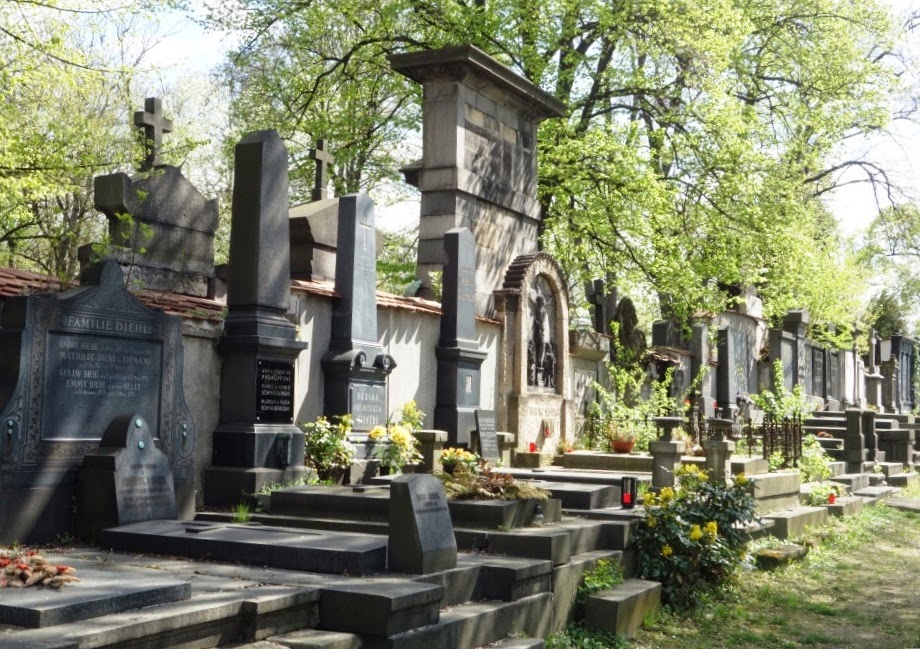It's been a while since I blogged, but I wanted to share my 5-hour odyssey into Prague's Olsany Cemetery that happened this past spring. It's the largest burial ground in the Czech Republic, once holding 2 million burials, according to Wikipedia. It was started in 1680 to bury mass numbers of plague victims. It's truly a necropolis, consisting of 12 separate cemeteries, but they merge together seamlessly, probably because of hundreds of years' worth of ivy growth. Seriously, I have never seen so much ivy in one place, ever in my life. When I sat on the steps of an old mausoleum to eat my lunch, you could almost hear it growing amidst the multitude of bird songs. Lovely, creepy, humbling and uplifting, all at the same time. Combined with so many hauntingly beautiful art nouveau monuments, I was in heaven, right here on earth. And I managed to contain myself and take only 500 pictures. (They're not all here, calm down.) Hope you enjoy these.
.JPG)
 |
| I literally screamed when I saw this one. Everything I've ever wanted in a tombstone. Mine is going to look like this! |
 |
| Ivy, ivy everywhere..... |
 |
| Incredible mausoleums with a Southern European feel |
 |
| There were some amazing bronze statues here |
.JPG) |
| These (rusty) iron crosses were also used by Eastern European immigrants that came to America in the late 19th and early 20th centuries. I find them frequently in cemeteries in areas like Scranton and Wilkes Barre, where many of those immigrants settled to work in the mines and factories. Note the light at the bottom, which probably held candles in the past on special holidays. |
.JPG) |
| Missing its urn by her elbow, and on the front was probably a china portrait of the deceased. |
.JPG) |
| Upside down posey-bouquet symbolizes mortality as well as remembrance. China portraits used to adorn this. |
.JPG) |
| My bizarre selfie |
.JPG) |
| The basket I suppose was for a potted plant or cut flowers, and to the right, it looks like there was a metal plate with the deceased's information on it, once. |
.JPG) |
| Detail of my favorite!! |
.JPG) |
| Details from last monument... |
.JPG) |
| I was here right after Easter |
.JPG) |
| What was in the cut-out? Or is it supposed to be there? |
.JPG) |
| Seriously.......that is a ton of ivy. |
.JPG) |
| So many of the monuments were completely consumed by the ivy. |
.JPG) |
| Karel Jonas (right) was born in Bohemia in 1840 and was a journalist and political activist. He moved to London and then Wisconsin, where he edited a Czech-language newspaper and was involved in local and state politics, even becoming Lt. Governor in the late 1880s. President Grover Cleveland appointed him US Consul to Prague, and later he served as the same in St. Petersburg and then in Germany. It has only recently been discovered that he shot himself in 1896, though the US Department of State claimed then that his cause of death was heart failure. His body was buried in Olsany Cemetery. |
.JPG) |
The Entz-Kinzelberger family plot, they were a well-to-do Jewish manufacturing family whose descendants include the poet Ranier Maria Rilke. One of his works: "The Walk"
My eyes already touch the sunny hill,
going far ahead of the road I have begun.
So we are grasped by what we cannot grasp;
it has its inner light, even from a distance –
and changes us, even if we do not reach it,
into something else, which, hardly sensing it, we already are;
a gesture waves us on, answering our own wave ...
but what we feel is the wind in our faces.
"The Walk" by Rainer Maria Rilke (1924)
Translated by Robert Bly
|




.JPG)
.JPG)
.JPG)
.JPG)
.JPG)
.JPG)
.JPG)
.JPG)
.JPG)
.JPG)
.JPG)

.JPG)






.JPG)
.JPG)
.JPG)
.JPG)
.JPG)
.JPG)
.JPG)
.JPG)
.JPG)
.JPG)
.JPG)
.JPG)
.JPG)
.JPG)
.JPG)
.JPG)
.JPG)
.JPG)
.JPG)
.JPG)
.JPG)
.JPG)
.JPG)
.JPG)
.JPG)
.JPG)
.JPG)
.JPG)
.JPG)
.JPG)
.JPG)
.JPG)
.JPG)
.JPG)
.JPG)
3 comments:
i miss you Taphy. your photos are amazing i made one my desktop
Wow! These are beautiful.Imagine what might be under the ivy.
Tammy--visiting any cemetery brings questions of, Who were these people? I've visited a few to photograph Americans who died during the wars.
My most saddest visit was to a cemetery in Allendale, S.C. I was there to photograph the marker for a woman Army nurse who died in Vietnam. Unmistakenly I along with my colleague ended up at a cemetery that was poorly maintained, so much that horrid red ants were burrowing into the graves. Grass and overgrown shurbs were evident everywhere.
Later I learned that I and my colleague had ventured into the wrong cemetery...it was..."..the Black Cemetery".
My immediate thought was that in this southern community where prejudice rules, people of color were so consumed with so manny tasks just to survive, that the last thing they needed to do was to give perpetual are to their ancestors that were buried in this cemetery.
I, being immersed with writing about Vietnam dead, was so curious to see that in this cemetery there was a U.S. military markter for Black officer who died AFTER he returned from the War. Why? How?
If there are family members alive, will they share their story of this man with me?
Post a Comment